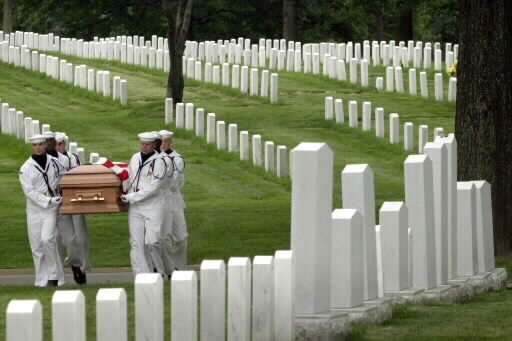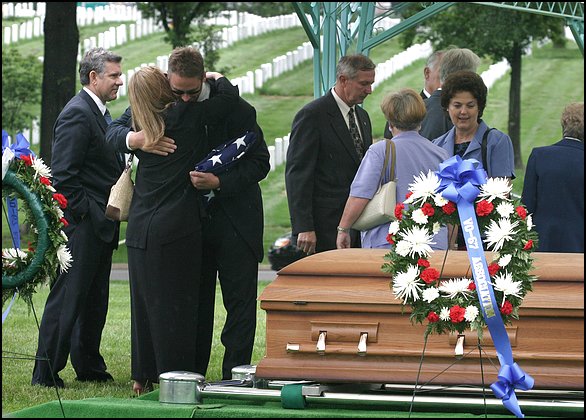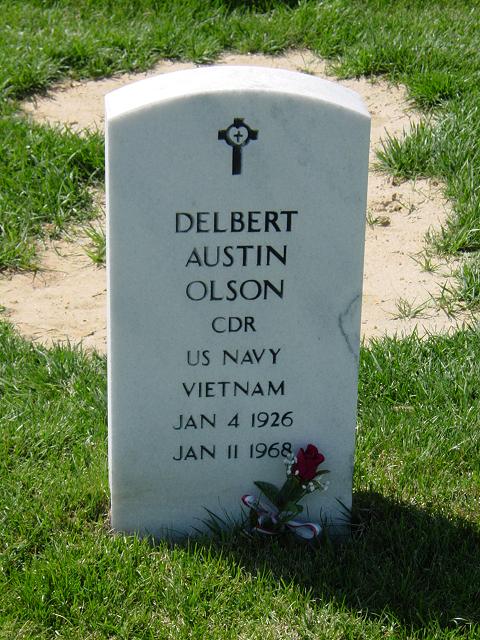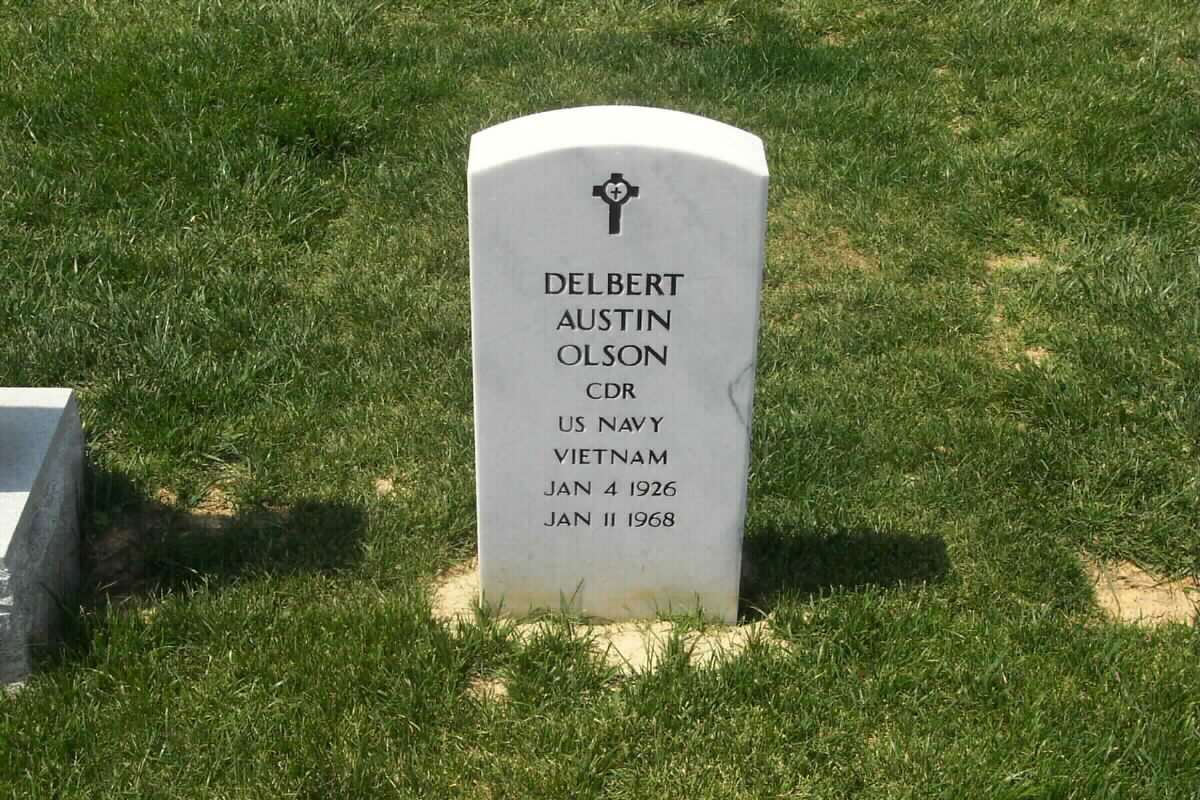Delbert Austin Olson was born on January 4, 1926 and joined the Armed Forces while in Casselton, North Dakota.
He served as an aviator in the Navy. In 22 years of service, he attained the rank of Commander/O5. He began a tour of duty on January 11, 1968.
Delbert Austin Olson is listed as Missing in Action.
At Last, Flight Crew at Rest
Burials End 35-Year Wait to Honor Men Lost in Secret Mission
Courtesy of the Washington Post
Wednesday, June 18, 2003
The mourners who gathered at Arlington National Cemetery yesterday included widows who have become frail since their husbands died at the height of the Vietnam War, children now grown into middle-aged parents, and comrades in arms turned gray.
For 35 years, they had waited to bring home the nine men, members of a secret Navy squadron who perished when their plane plowed into a Laotian mountainside on a mission so hush-hush the government wouldn't speak of it for years. They maintained hope when one recovery effort after another failed to retrieve everyone's bones from treacherous ledges on a sheer cliff surrounded by a snake-infested jungle. After all, they assured themselves, the military is expected to move mountains to bring back its dead from the battlefield.
This week, three decades of waiting end with a series of funerals that hold a measure of hope for families of the 1,876 Americans still unaccounted for from the war in Southeast Asia.
Two crew members from the Navy plane that crashed in Laos in January 1968 were buried yesterday; three more will be in the next two days. In addition, there will be a group funeral today at Arlington, with a coffin holding bone fragments that DNA analysis could not identify.
Three other crew members already have been laid to rest in the past month. Arrangements are undecided for the ninth crew member. The crew's mascot, a bull terrier named Snoopy who died in the crash, will be buried elsewhere because Arlington cemetery does not permit dogs to be interred.
Many believed the crewmen's remains would never be retrieved from the remote and unforgiving mountainside, where their bodies were located within days of the crash. For a time, it was considered too dangerous to risk other men's lives attempting the recovery of dead men's remains.
But family and friends persevered. One son threatened to launch his own recovery mission in a rented helicopter, and former squadron mates mounted a letter-writing campaign urging the federal government to bring the Navy crew home. From 1993 to 2002, investigative teams returned to Laos six times, battling monsoons, poisonous vipers and leeches as they rappelled down the north wall of Phoulouang Mountain, to recover bone fragments that took more than a year to analyze.
This week's funerals are the reason the teams led by Joint Task Force Full Accounting — a unit established to find missing service members — kept returning.
“It's sad, and you could cry at any moment, but it's a celebration, too,” said Sue Jenkins, whose husband, Lieutenant (j.g.) Denis Anderson, will be buried tomorrow, as she left the funeral yesterday of his flight crew leader, Commander Delbert Olson. “It's a promise kept.”
Their secret squadron was called VO-67. Formed in 1967, it existed for 500 days. Twelve nine-man crews flew hundreds of dangerous missions along the Ho Chi Minh Trail in Laos and Cambodia, which remained classified information because the United States was denying that its forces were operating in those officially neutral countries.
In an effort to stop North Vietnamese troops and supplies from moving south into the war zone, the Navy had twin-engine OP-2E Neptunes drop sensors along the trail that burrowed into the ground to monitor footsteps and truck movements or that hung in trees to eavesdrop on conversations. The network was called “McNamara's Line,” after then-Defense Secretary Robert S. McNamara.
The U.S. planes flew perilously close to the ground, in straight lines for several minutes at a time, and thus were ready targets.
“We all knew it was going to be dangerous,” said retired Navy Commander Adam Alexander, 73, who headed a VO-67 crew. “I'd go right down the treetops. To this day, my crew swears that when we landed, I had limbs hanging on my engines.”
During a six-week period in 1968, the squadron lost three planes and 20 crewmen, including the nine aboard Olson's plane.
Flying alongside Olson the morning of January 11, 1968, Alexander had just finished ropping his sensors and climbed above the clouds. Listening in on Olson's frequency, Alexander heard him tell the forward air controller, “I am going down through this hole in the clouds.”
“And that's the last thing you heard,” said Alexander, who considered Olson a skilled pilot and believes that he was shot down.
Twelve days later, an Air Force reconnaissance plane located the crash site on the sheer side of Phoulouang Mountain, about 150 feet below the 4,583-foot summit. The cockpit was burrowed into the mountain; a section of the fuselage landed below on a nine-foot-wide ledge. The landing gear was on another ledge, 200 feet below the first, and the tail an additional 400 feet down on a third ledge.
The bodies of a few crewmen could be seen scattered across the site, along with that of the mascot, Snoopy.
For the next three decades, the site was virtually untouched.
“It's an extremely hazardous mountain,” said Tom Holland, scientific director of the Army's Central Identification Laboratory in Hawaii, which did a series of DNA tests on the bone fragments. “That's the reason no recovery could be attempted at the time of the initial loss.”
That and the fact that the area was heavily defended.
The first three investigative teams, sent in 1993, 1994 and 1995, failed to locate the crash. A fourth team, deployed in 1996, recovered some human remains and dog tags but was forced to stop because of the dangerous conditions.
“I was upset,” said David Olson of Prairie Village, Kansas, who was 7 when his father died. “Everybody who goes and fights for his country deserves to come back, hopefully alive. I wanted to try again. I was ready to get a helicopter and go. A dear friend who works in the aerospace industry was going to fly with me, to get people to get the guys out.”
David Olson was not the only one frustrated by the lack of progress. Squadron members who started having reunions in 1999, one year after their mission was declassified, began lobbying government officials, urging that recovery efforts resume.
Holland said the team was ready to try again, anyway. “It reached a point after we had done some recoveries in Tibet and China on similar sorts of terrains, we realized this site was within our capability,” he said.
The mission still was one of the most difficult ever conducted. Because of cloud cover and monsoons, teams could be sent only during February and March. Twice, in 2000 and 2001, a team flew in by helicopter and rappelled down to the crash site. They brought a medic because of the potential for fatal snakebites from bamboo vipers and banded kraits. They hacked through thick vines with machetes. They trod on ground undulating with leeches. They camped on the mountain for weeks at a time.
“Why?” Holland said. “Because those men . . . were somebody's husband, father, brother or son. It's a debt we owe, one generation to another. It's not only keeping faith with a generation past, but with a generation in the future that is going to be sent in harm's way. It says, if something happens, we're going to get you back.”
To the sons and daughters of those who died and to the men they served with, the risk was worth taking.
“This gave me one more chance to do something in my father's honor,” said Richard Mancini, 36, of Amsterdam, N.Y., who last month buried his father, Petty Officer 2nd Class Richard Mancini, and is attending the Arlington funerals this week. “The only thing I'd ever done for him was to escort his body from Hawaii to America.”
Also on that flight was Sean Siow, who was only 2 weeks old when his father, Petty Officer 3rd Class Gale Siow, was lost.
Siow, who lives in San Jose, will see his father buried tomorrow at Arlington. “It was something I felt I had to do,” he said. “Anyone who has someone missing from a war, I hope it gives them hope.”
Like Mancini and Siow, most of the relatives who have gathered for one final goodbye say they consider the occasion a happy one.
“It's a great day, because he's home,” said Eric Thoresen, 37, of Phoenix shortly after burying his father, Petty Officer 2nd Class Donald Thoresen, yesterday morning. “I lived all my life wondering, ‘What if he is still alive, living in the jungle, even starting a new family?' This brings closure.”
Where the naval airmen lay for 34 years, there is a bronze plaque bearing their names. In all the years they were on “this sacred Laotian mountain,” the plaque reads, “these VO-67 heroes were not forgotten by their country.”
July 11, 2001
Remains of Servicemen Returned
HICKAM AIR FORCE BASE, Hawaii (AP) — David Olson was 7 when his father's plane went down during the Vietnam War.
Among the few details relatives learned about the January 11, 1968, crash, one struck Olson as particularly odd: His father was lost in Laos, where the United States supposedly wasn't involved.
Thirty years went by before Olson learned why. Newly declassified documents told him Navy Commander Delbert Olson and his crew of eight were on a secret mission to drop eavesdropping devices, supposedly along the Ho Chi Minh Trail, when their Neptune OP-2E crashed 20 miles inside Laos.
On Tuesday, Olson began what he hopes will be the final stretch of his search for
answers.
He watched from the tarmac at Hickam Air Force Base as an Air Force plane arrived with 17 sets of remains believed to be U.S. servicemen unaccounted for from the Vietnam and Korean wars.
Some of those remains were recovered on the same mountainside in Laos where Commander Olson's plane went down. An earlier mission to the crash site had brought back remains of two of the Navy pilot's crewmates.
Olson hopes his father's remains are among those he saw Tuesday carried in flag-draped caskets by a military honor guard and taken to the Army's Central Identification Laboratory at Hickam for formal identification.
“It was everything I expected,” said Olson, 40, of Prairie Village, Kansas. “`Something we've waited for for 33-plus years.”
Olson's father was a member of Observation Squadron 67, which worked to build the eavesdropping network known as “McNamara's Line.” Then-Defense Secretary Robert McNamara had devised the plan of dropping camouflaged sensors from low-flying planes to monitor enemy troop movement and trucks along the Ho Chi Minh Trail.
“There's 300 other members of this squadron who are very thankful for all this,” said Bob “Dusty” Reynolds, of San Jose, Calif., a squadron member who attended Tuesday's arrival ceremony. “They need closure also.”
The remains that arrived Tuesday included five from Vietnam, eight from North Korea and four from Laos.
The repatriations are part of ongoing efforts by the military's Joint Task Force-Full Accounting and the Central Identification Laboratory to account for U.S. servicemen missing in wars.
The remains from Laos were recovered in March at a crash site on the slopes of 4,600-foot Phoulouang Mountain.
A search party on the mountain in 1996 had found remains later identified as belonging to two men from Olson's crew, but the team deemed the jungle terrain too dangerous to continue that search.
The families of the crew pressured then-President Clinton and Congress for another attempt.
The 30-day mission back to the mountain in March was not without challenges, said Johnie Webb Jr., deputy director of the Central Identification Laboratory. He said
the recovery team camped out on the rugged mountain slope amid poisonous snakes. Food and drinking water had to be flown in while they worked.
Webb said a recovery team may return to the mountain for another sweep of the wreckage, which was scattered across four ledges.
The identification process is expected to take several months. When it is complete, Olson hopes his father's remains will be identified among those returned. He then hopes to return to Hawaii to escort his father's remains to Arlington National Cemetery in Washington.
“That's what he would have wanted,” Olson said.
Since 1973, the remains of 619 American servicemen from the Vietnam War have
been identified; 1,966 are still unaccounted for, including 417 in Laos.
29 May 2003:
After 35 years, nine Navy fliers killed in Vietnam War will be buriedTopeka, Kansas – Next month, at Arlington National Cemetery, Sue Jenkins will fulfill a request her late husband made 36 years ago, before he left for service in Vietnam.Lieutenant (jg) Denis Anderson, a Navy flier who grew up in Hope, Kansas, told his wife of almost a year that if anything happened to him, he wanted to be buried at Arlington.
The request came “casually out of the blue,” Jenkins, who grew up in Kansas City, Kansas, recalled Wednesday. “I thought he said he wanted to be buried at the national cemetery in Abilene. But there's no national cemetery there. He probably said Arlington. I didn't want to hear it anyway.”
David Olson of Prairie Village will be at Arlington next month as well, and he will reach what he calls closure. He was 7 years old when his father, Navy Commander Delbert A. Olson of Casselton, North Dakota, last hugged him goodbye.
Denis Anderson and Delbert Olson never made it home from Southeast Asia.
On January 11, 1968, they and seven other crew members were aboard a OP-2E Neptune on a mission over Laos when the plane crashed into the side of a mountain.
There they remained for more than 30 years.
A chance to fly
Denis Anderson and Sue Littlefield met while students at college in Chicago. They fell in love, got married and planned to be missionaries.
Marilyn Anderson, who still lives in Hope and is the wife of one of Denis Anderson's cousins, remembers “just a good Christian kid.
“He wanted to grow up to be a missionary. That was his purpose.”
That was why he joined the Navy.
“He thought it would be a great opportunity to learn to fly,” Marilyn Anderson said, and flying skills would be useful in getting him around in the remote areas he would be assigned.
During the Vietnam War, Anderson and Olson were part of a special squadron whose job was to sow sound and seismic sensors along the Ho Chi Minh Trail, a North Vietnamese supply route that snaked through part of Laos.
On that January morning in 1968, Olson was the pilot and Anderson the co-pilot when they took off from a base in Thailand, on a mission with two other planes. The Neptunes, originally developed to seek out submarines, were slow-flying aircraft and were forced to fly low over the Laotian jungle, sometimes as low as 350 feet and exposed to enemy fire.
It was exceedingly dangerous duty
Dana Snyder, Delbert Olson's daughter who lives in Overland Park, recalled in a interview in 2001 that her father “knew his mission, that he had a 50 percent chance of making it back alive.”
A.G. Alexander of Whitefish, Montana, was a Navy commander piloting another plane on the 1968 mission and heard Olson's final radio communication.
“I tuned in on his frequency,” Alexander said. “That's when I heard him say he was going down through the clouds. Only God knows what happened.”
The plane carrying Anderson and eight others slammed into the side of the 4,583-foot mountain, just 150 feet from the top.
For months after the crash, Sue Jenkins said, she was unsure of her husband's fate, even though the Defense Department had labeled him “presumed killed in action.”
“For some time, I didn't know whether I was married or a widow,” she said. “One evening, God said: ‘I have him right here with me. You don't have to pray for him as a prisoner anymore.' ”
‘An answer to a prayer'
Within weeks of the crash, the wreckage was spotted on the mountainside, but the area was thought to be too steep and enemy troops too numerous to chance a recovery.
David Olson spent years urging civilian and military authorities to recover the bodies of his father and the other crewmen. He grew frustrated by the lack of information and action from the military.
At one point, he planned to launch his own expedition to the mountain to recover the bodies. He had gone so far as to arrange for a helicopter to carry his rescue party.
“We were getting to the point where we were going in to go get them, and finally the Navy stepped up,” Olson recalled Wednesday.
Alexander, the former Neptune pilot, and other veterans of the squadron also were instrumental in initiating the recovery effort.
“The government was putting out information that they had $15 million they were spending to find bodies,” Alexander said. “When they said that, the squadron organization said we know where there are nine bodies.
“They came back with a letter saying it's too dangerous.”
The former Neptune crew members' reply was simple enough: “It's no more dangerous for you now than it was for us then.”
That got the recovery efforts rolling in 1993, but it was slow work.
Between 1993 and 2002, six U.S.-Lao missions worked the site. One one mission, members of a recovery unit rappelled down a sheer cliff and found the remains of two crew members and one of Olson's dog tags.
Finally, the remains of all the crew members were recovered and returned to Hawaii. On Tuesday, the Pentagon announced the remains of all nine members of the crew had been positively identified.
Olson will be buried at Arlington on June 17, 2003, and Anderson will be laid to rest on June 19, 2003.
Some unidentified remains from all the dead crewmen will be buried in a common grave on June 18, 2003, with full military honors.
Sue Jenkins, who now lives in San Marcos, Texas, will accompany her late husband's remains from Honolulu to Washington, D.C. The Rev. Thomas Jenkins, her husband since 1970, will conduct the burial ceremony.
While in Honolulu, she will get back the wedding ring she gave her husband in 1966. It was recovered on the Laotian mountain.
“I'm ecstatic about that,” she said. “It was an answer to a prayer.”
And David Olson has reached his goal.
“It's the end of the journey,” he said. “It's something they deserve. Everyone says it's closure. Everyone who fights for their country deserves to be brought home.”



Michael Robert Patterson was born in Arlington and is the son of a former officer of the US Army. So it was no wonder that sooner or later his interests drew him to American history and especially to American military history. Many of his articles can be found on renowned portals like the New York Times, Washingtonpost or Wikipedia.
Reviewed by: Michael Howard

